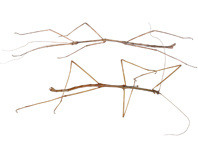Abstract
The new genus Andeocalynda n. gen. is described and the supposed relationships are discussed. The genus is restricted to the mountainous Andean regions of Ecuador and Colombia. Nine new species are described and illustrated: A. aspericollis n. sp., A. banosense n. sp., A. brevicercata n. sp. and A. lojaense n. sp. from Ecuador based on the males only, A. decorata n. sp., A. mutica n. sp., A. densegranuloa n. sp. and A. tuberculata n. sp. from Ecuador as well as A. putumayoense n. sp. from Colombia based on the male and female. The eggs of the two new Ecuadorian species A. decorata n. sp. and A. tenuis n. sp. are described and illustrated. Two species, previously attributed to other genera are transferred to Andeocalynda n. gen., this is: A. carrikeri (Hebard, 1919) from the genus Bacteria Berthold, 1827 (n. comb.) and A. comis (Bates, 1865) from the genus Clonistria Stål, 1875 (n. comb.). As a result, Andeocalynda n. gen. currently includes eleven known species.
References
Bates, H.W. (1865) Descriptions of fifty-two new species of Phasmidae from the collection of Mr. W.W. Saunders, with remarks on the family. Transactions of the Linnean Society London, 25 (1), 321–359.
https://doi.org/10.1111/j.1096-3642.1865.tb00187.x
Bradler, S. (2009) Die Phylogenie der Stab- und Gespenstschrecken (Insecta. Phasmatodea). Species Phylogenie and Evolution, 2, 3–139.
https://doi.org/10.17875/gup2009-710
Brunner v. Wattenwyl, C. (1907) Phasmidae Anareolatae (Clitumnini, Lonchodini, Bacunculini). In: Die Insektenfamilie der Phasmiden. II. Verlag von Wilhelm Engelmann, Leipzig, pp. 181–340, pls. 7–15.
Clark-Sellick, J.T. (1997) Descriptive terminology of the phasmid egg capsule, with an extended key to the genera based on egg structure. Systematic Entomology, 22, 97–122.
https://doi.org/10.1046/j.1365-3113.1997.d01-30.x
Clark Sellick, J.T. (1998) The micropylar plate of the eggs of Phasmida, with a survey of the range of plate form within the order. Systematic Entomology, 23, 203–228.
https://doi.org/10.1046/j.1365-3113.1998.00056.x
Conle, O.C., Hennemann, F.H. & Gutiérrez, Y. (2011) The Stick Insects of Colombia. A catalogue and bibliography with the descriptions of four new genera and 74 new species. Books on Demand GmbH, Norderstedt, 406 pp.
Hebard, M. (1919) Studies in the Dermaptera and Orthoptera of Colombia. Part I.. Transactions of the American Entomological Society, 45, 89–178, pls. 16–23.
Hebard, M. (1924) Studies in Dermaptera and Orthoptera of Equador. Proceedings of the Academy of Natural Sciences of Philadelphia, 76, 109–248, plates 5–7.
Hennemann, F.H. & Conle, O.V. (2020) Studies on Neotropical Phasmatodea XIX: The enigmatic genus Laciphorus Redtenbacher, 1908 from Coastal Peru (Phasmatodea: Diapheromeridae: Diapheromerinae). Studies on Neotropical Fauna and Environment, pp 1–8.
https://doi.org/10.1080/01650521.2020.1736743
Hennemann, F.H., Conle, O.V. & Valero, P. (2020) Studies on Neotropical Phasmatodea XXV: Bostriana n. gen., a new genus of Diapheromerinae from Coastal Peru (Phasmatodea: Diapheromeridae: Diapheromerinae). Studies on Neotropical Fauna and Environment. [in press]
Kirby, W.F. (1904) A Synonymic Catalogue of Orthoptera. 1. Orthoptera Euplexoptera, Cursoria et Gressoria. (Forficulidae, Hemimeridae, Blattidae, Mantidae, Phasmidae). British Museum, London, 501 pp. [http://biodiversitylibrary.org/page/6196392]
Meyers, N. (2000) Biodiversity hotspots for conservation priorities. Nature, 403, 853–858.
https://doi.org/10.1038/35002501
Morrone, J.J. (2006) Biogeographic areas and transition zones of Latin America and the Caribean Islands based on panbiogeographic and cladistic analyses of the entomofauna. Annual Review of Entomology, 51, 467–494.
https://doi.org/10.1146/annurev.ento.50.071803.130447
Otte, D. (1978) The primary types od Orthoptera (Saltatoria, Mantodea, Phasmatodea and Blattodea) at the Academy of Natural Sciences of Philadelphia. Proceedings of the Academy of Natural Sciences of Philadelphia, 130, 26–87.
Otte, D. & Brock, P. (2005) Phasmid Species File. Catalog of Stick and Leaf Insects of the World. The Insect Diversity Association and the Academy of Natural Sciences, Philadelphia, 414 pp.
Redtenbacher, J. (1906) Phasmidae Areolatae. In: Insektenfamilie der Phasmiden. I. Verlag von Wilhelm Engelmann, Leipzig. pp. 1–180, pls. 1–6.
Redtenbacher, J. (1908) Phasmidae Anareolatae (Phibalosomini, Acrophyllini, Necrosciini). In: Die Insektenfamilie der Phasmiden. III. Verlag von Wilhelm Engelmann, Leipzig, pp. 341–589, pls. 16–27.
Robertson J. A., Bradler S. & Whiting M.F. (2018) Evolution of oviposition techniques in stick and leaf insects (Phasmatodea). Frontiers in Ecology and Evolution, 6 (216), 1–16.
https://doi.org/10.3389/fevo.2018.00216
Simon, S., Letsch, H., Bank, S., Buckley, T.R., Donath, A., Liu, S., Machida, R., Meusemann, K., Misof, B., Podsiadlowski, L., Zhou, X., Wipfler, B. & Bradler, S. (2019) Old World and New World Phasmatodea: Phylogenomics Resolve the Evolutionary History of Stick and leaf Insects. Frontiers in Ecology and Evolution, 7 (345), 1–13.
https://doi.org/10.3389/fevo.2019.00345
Zompro, O. (2001) A generic revision of the insect order Phasmatodea: The New World genera of the stick insect subfamily Diapheromeridae: Diapheromerinae = Heteronemiidae: Heteronemiinae sensu Bradley & Galil, 1977. Revue Suisse de Zoologie, 108 (1), 189–225.
https://doi.org/10.5962/bhl.part.79626


